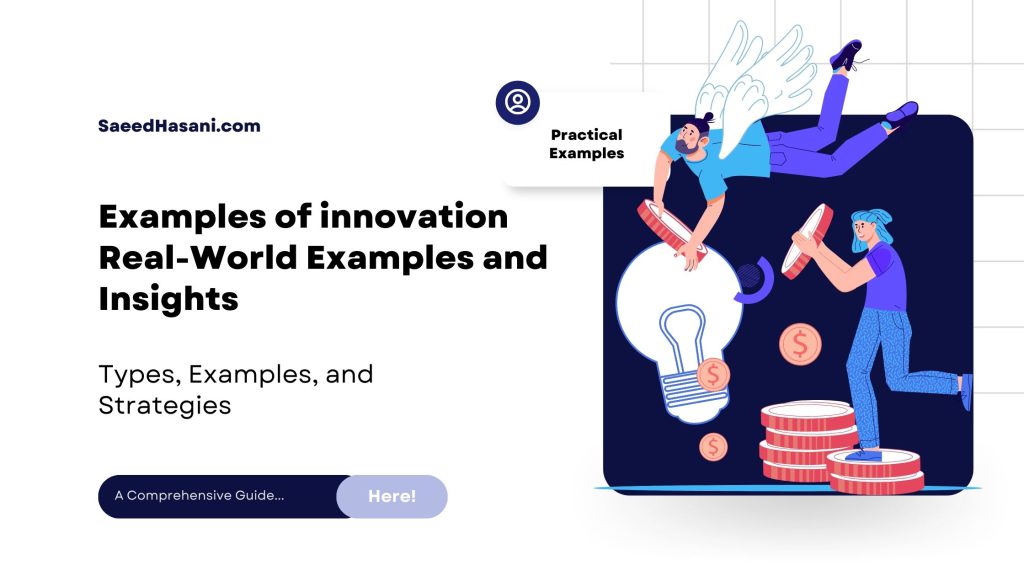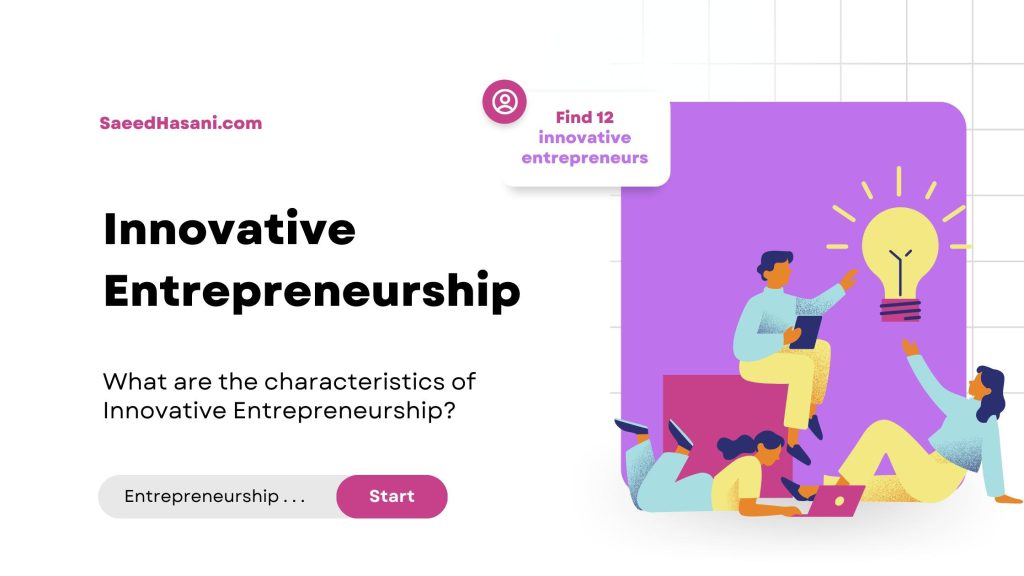Examples of innovation | Real-World Examples and Insights

Businesses today are rapidly evolving. Therefore, innovation is the cornerstone of success, driving growth and competition among industries. This comprehensive guide examines the multifaceted nature of innovation, explains its different types, provides clear definitions and shows their practical applications through real-world examples, and tries to give you a better understanding of innovation with Examples of innovation.
From technological breakthroughs to social impact and responsible innovation, innovation encompasses a wide range of transformative forces that advance progress and address emerging challenges, making innovation an essential catalyst for change and improvement in business and society.
Content Overview:
Types of Innovation
Innovation can be categorized in several ways, but a common approach involves classifying it along two dimensions: the technology used and the market in which it operates.
Beyond the innovation matrix, other frameworks help organizations discover opportunities for improvement and value creation. Let’s examine some alternative types of innovation:
– Technological Innovation
Technological innovation forms the foundation of modern progress. It involves the development of new technologies, processes, or products that can revolutionize industries and markets. For example, we can mention the Internet of Things (IoT), mobility solutions, cloud computing, artificial intelligence (AI), augmented reality (AR), and big data.
Technological innovation involves the introduction of new or improved technology, machinery, or technology-based processes. It enhances productivity, reduces costs, and improves product quality.
Examples of innovation:
Advancements in smartphone technology, health devices, and wireless home sound systems are technological innovations that have transformed consumer experiences.
Google’s Search Engine – Technological Advancement:
Google’s search engine, founded in 1998, introduced a faster and more accurate search algorithm. The company’s ongoing innovations include voice search, image search, and personalized search results.
– Product Innovation
Product innovation focuses on creating new or significantly improved products with unique features or applications. Light bulbs, televisions, and airplanes are great examples of product innovation.
Product innovation focuses on enhancing the functionality, features, or characteristics of a product. That can include new technologies or a combination of existing technologies to create tangible improvements.
Examples of innovation:
The introduction of wireless headphones or the addition of a dynamic turn indicator in cars shows product innovation and is considered a good example of innovation.
– Process Innovation
Process innovation seeks to optimize production or service delivery processes, improving efficiency and effectiveness. Examples include AliExpress’ dropshipping model, Spotify’s music-streaming services, and Henry Ford’s assembly line process.
Process innovation focuses on enhancing production or delivery methods, often through the application of new technology or improved processes. It aims to save time, reduce costs, and serve customers more efficiently.
Examples of innovation:
Automated replenishment ordering for retail stores, using statistical models to optimize inventory levels, is a process innovation that improves efficiency and customer service.
– Service Innovation
Service innovation addresses the intangible aspects of problem-solving, improving processes, people skills, and materials to enhance customer experiences. Cloud computing and technological banking services exemplify service innovations.
Service innovation aims to improve or introduce new service concepts, products, or processes. It may involve changes in customer interaction, delivery methods, or user interfaces.
Examples of innovation:
Uber expanded its service offerings with UberEATS, leveraging its brand and technology to enter adjacent markets.
Amazon Prime – Service Innovation Redefined:
Amazon Prime, launched in 2005, revolutionized e-commerce by offering fast, free shipping and access to streaming content. Amazon has continued to innovate with services like grocery delivery (Amazon Fresh) and cashier-less stores (Amazon Go). These types of services are examples of innovation.
– Business Model Innovation
Business model innovation entails reimagining existing business models or creating entirely new ones to satisfy customer needs better. Companies like Xerox, Netflix, and Dell have successfully pioneered new business models.
Business model innovation represents a fundamental change in how a company delivers value to customers or captures it from the market. It often involves new pricing mechanisms, revenue streams, or distribution channels.
Examples of innovation:
The shift from traditional music purchasing to digital streaming services, like iTunes and Spotify, illustrates business model innovation. If we want to introduce one of the best examples of innovation, we can mention Spotify.
Netflix Online Streaming – Business Model Transformation:
Netflix’s transition from a DVD rental service to an online streaming platform in 2007 is a remarkable example of business model innovation. The company now produces original content and offers personalized recommendations and offline viewing.
Square – Business Model Innovation in Payments:
The company’s innovations include cash advances and payroll services.
– Radical Innovation
Radical innovation introduces entirely new concepts, challenging existing norms and boundaries. Innovations like the Apple iPhone, washing machines, and personal computers have reshaped our lives.
The simultaneous introduction of revolutionary technology and new business models characterizes radical innovation. These innovations tackle global challenges, offering solutions in novel ways, often transforming entire markets or economies.
Examples of innovation:
Technological advancements like personal computers and the internet have been radical innovations that reshaped the way the world functions and communicates. In the following, you will get acquainted with Examples of innovation for Radical Innovation.
Emerging innovations, such as robotics, AI, blockchain technology, energy storage, and genome sequencing, have the potential to drive further radical transformation.
– Social Innovation
Social innovation addresses societal needs through changes in social practices, leading to broader transformations in systems and structures. Charter schools, emissions trading, and microfinance represent impactful social innovations.
Social innovations aim to meet social needs more effectively than existing solutions, improving conditions, education, communities, or public health. They can be funded or provided by public or commercial entities.
Examples of innovation:
Innovations like potable water generators and platforms connecting students with seniors for assistance in various tasks showcase the power of social innovation.
– Incremental Innovation
Incremental innovation involves gradual and continuous improvements to existing products, processes, or services within established markets. These innovations may not introduce groundbreaking changes but focus on refining and enhancing existing offerings.
Examples of innovation:
Consider the evolution of televisions. While the core technology remains largely the same, incremental innovations have led to the development of sleeker, more user-friendly models that cater to diverse customer preferences and needs.
Apple’s iPhone – A Testament to Incremental Innovation:
The iPhone, introduced in 2007, is a classic example of incremental innovation. It improved upon existing technology with features like a touchscreen interface, visual voicemail, and a built-in web browser. Apple has continued to innovate with each new release, introducing features like facial recognition and augmented reality.
– Disruptive Innovation
Coined by Clayton Christensen, disruptive innovation refers to concepts, products, or services that create new value networks by either entering existing markets or establishing entirely new ones. Initially, disruptive innovations may not meet the standards set by traditional value metrics but cater to a niche market segment.
Examples of innovation:
Tesla disrupted the automotive industry with its electric vehicles and advanced software capabilities. Traditional car manufacturers needed help to keep pace with Tesla’s unique capabilities, such as battery technology and rapid iteration.
Tesla Electric Cars – Driving Disruptive Innovation:
Tesla’s electric cars disrupted the automotive industry by introducing the Roadster in 2008, the first production electric car using lithium-ion batteries. Tesla’s commitment to innovation includes features like Autopilot and a massive touchscreen interface, setting the standard for electric vehicles.
Uber – Disrupting Transportation:
Uber, founded in 2009, disrupted the transportation industry with its ride-sharing platform, offering a convenient alternative to traditional taxis. Uber continues to innovate with services like Uber Eats and electric bike and scooter rentals.
– Sustaining Innovation
Sustaining innovation seeks to improve and grow existing markets by meeting customer needs more effectively. These innovations typically result in slightly better product performance and reduced defects, catering to both high-end customers and cost-conscious mainstream markets.
Examples of innovation:
The iPhone, while once considered a disruptive innovation, now falls into the category of sustaining innovation. New iPhone models appeal to the same customer segments, offering incremental improvements without radically changing the product.
– Marketing Innovation
Marketing innovation focuses on opening new markets or increasing market share by making significant changes to traditional marketing approaches. It can involve innovative marketing practices or promoting existing products in novel ways.
Examples of innovation:
L’Oréal’s Makeup Genius App enhances customer engagement and online shopping experiences by using technology to suggest products matching personal preferences. The activity of this company is an example of innovation.
– Architectural Innovation
Architectural innovation reconfigures existing product technologies to improve component combinations and interactions. It often entails less technological risk but requires market demand for the reconfigured product.
Examples of innovation:
Networked computer systems and flexible manufacturing systems represent architectural innovations that optimize component interactions.
– Responsible Innovation
Responsible innovation emphasizes ethical, sustainable, and socially desirable aspects of the innovation process and its products. It encourages collaboration between innovators and societal stakeholders to ensure the responsible development and deployment of new technologies.
– Design-Driven Innovation
Design-driven innovation focuses on understanding sociocultural dynamics and creating products with unique meanings and languages. Examples include the iconic mini skirt, Bird kettle, and Panda car.
– Disruptive Innovation
Disruptive innovations redefine industries by offering products or services that outperform traditional solutions, often at a lower cost. Companies like Facebook, Google, and FedEx have disrupted their respective markets with novel approaches.
How to Foster Innovation?
Creating innovation is essential for businesses aiming to thrive in today’s dynamic environment. To help organizations of all sizes and industries nurture innovation, our book, “How to Create Innovation,” offers comprehensive guidance. Authored by industry experts, it provides insights and strategies based on years of experience in driving innovation for businesses. You can read this book to learn more about Examples of innovation.
Conclusion
Innovation is a versatile and indispensable force that manifests in various forms, propelling progress in society and industry. These examples show the multitude of ways innovation can manifest, often converging in synergistic combinations to drive advancement.
Embracing innovation necessitates a thoughtful consideration of its broader societal, ethical, and sustainable implications, ensuring its role as a catalyst for positive change, addressing contemporary challenges, and fostering growth. Recognizing the dynamic nature of innovation, organizations can adapt, enhance customer experiences, and achieve sustainable growth by harnessing the potential of these diverse innovation types.
Whether starting again on innovation or refining existing strategies, innovation remains the linchpin for unlocking fresh opportunities and maintaining a competitive edge in today’s fast-paced business landscape. By reading about Examples of innovation, your mind will understand the concept of innovation better.







Responses